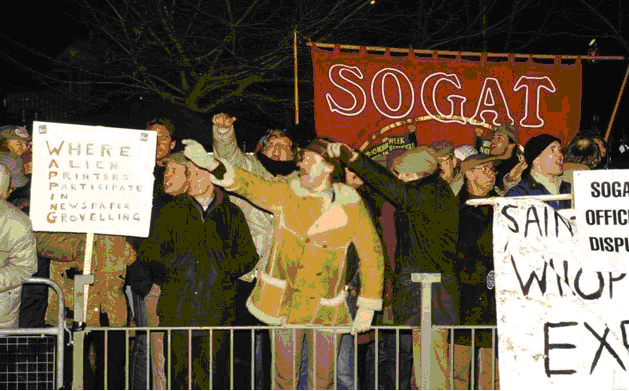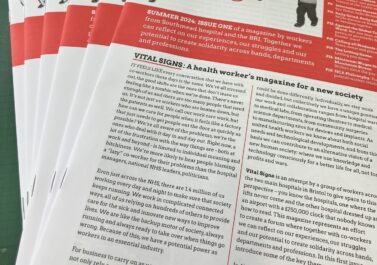Discussion meeting with a comrade who participated in the dispute.
Thursday, 10th of September 2020, 7pm UK time
E-mail us for the Zoom link: angryworkersworld@gmail.com
* The defeat of the News International print workers is sometimes talked about as if the outcome was inevitable, due to new printing technology. Is this true? What does it tell us about automation and workers’ power thirty five years on?
* ‘Picket’ was an independent workers’ bulletin that ran to 43 issues during the dispute. It became a key source of information, by and for strikers and supporters. What made it successful early on, and why didn’t it become a focus for organising independently of – and when necessary against – the print unions? What does it take to produce a decent political strike bulletin today?
* Two connected themes for a public meeting and discussion, opened by a printer who was involved in the picketing around News International’s Wapping operation, and in publishing ‘Picket’.
* Related questions which could be explored: • Was Wapping a strike, a lockout, an attempted occupation – or a combination of all three? • How could the strike have ended differently, and what would that have taken? Could the workers have ‘won’? What did they think winning meant? • News International pulled off a ‘bait-and-switch’ on its workers and the print unions, by which it provoked a strike on its own terms, while transferring production to the new Wapping factory without a hiccup. Did the workers really get taken by surprise? If so, why? • Before the dispute, Fleet Street print workers had a reputation as an ‘aristocracy of labour’ commanding fabulous pay and conditions, and wielding real day-to-day shop floor power. Is this true? Were potential allies put off by their exclusiveness, nepotism and pride in the job? To what extent did other workers and local working class people identify with and support the strike? • Printworkers were organised into a complex network of well-resourced unions that used closed shops to leverage wages, conditions and access to jobs. How did the unions play to their striking members, and how did they help organise defeat? • What tactics did the strikers and pickets use, and how did they evaluate the effectiveness of those tactics? • Are tech workers the new printers?
Background reading:
‘Picket’ issues 1-43. If you don’t have time to plough through, check the tone and content of some of the early issues and compare them with the late ones: http://libcom.org/history/picket-bulletin-wapping-printers-strike-1986-1987
Short timeline of the dispute: https://libcom.org/history/1986-1987-wapping-printers-strike
‘Paper Boys’ – personal account of the dispute written a year after it ended. The tone and views are fairly typical: http://marx.libcom.org/history/paper-boys-one-man%E2%80%99s-account-picketing-wapping



